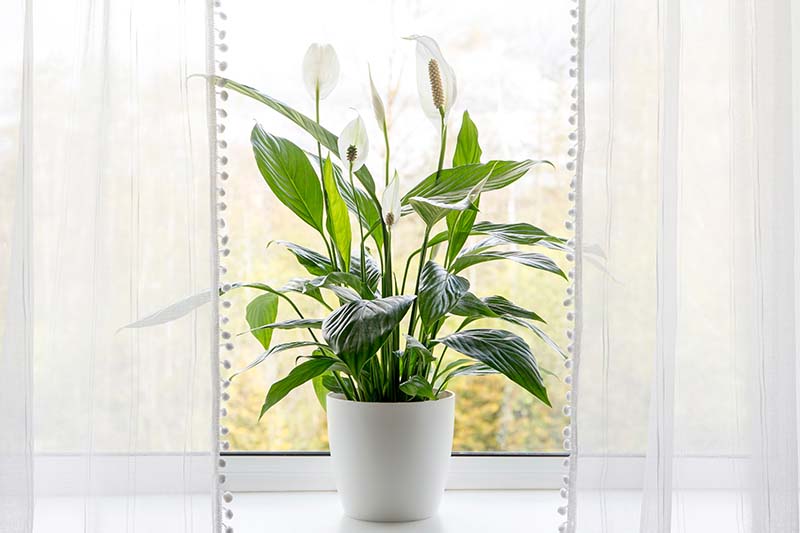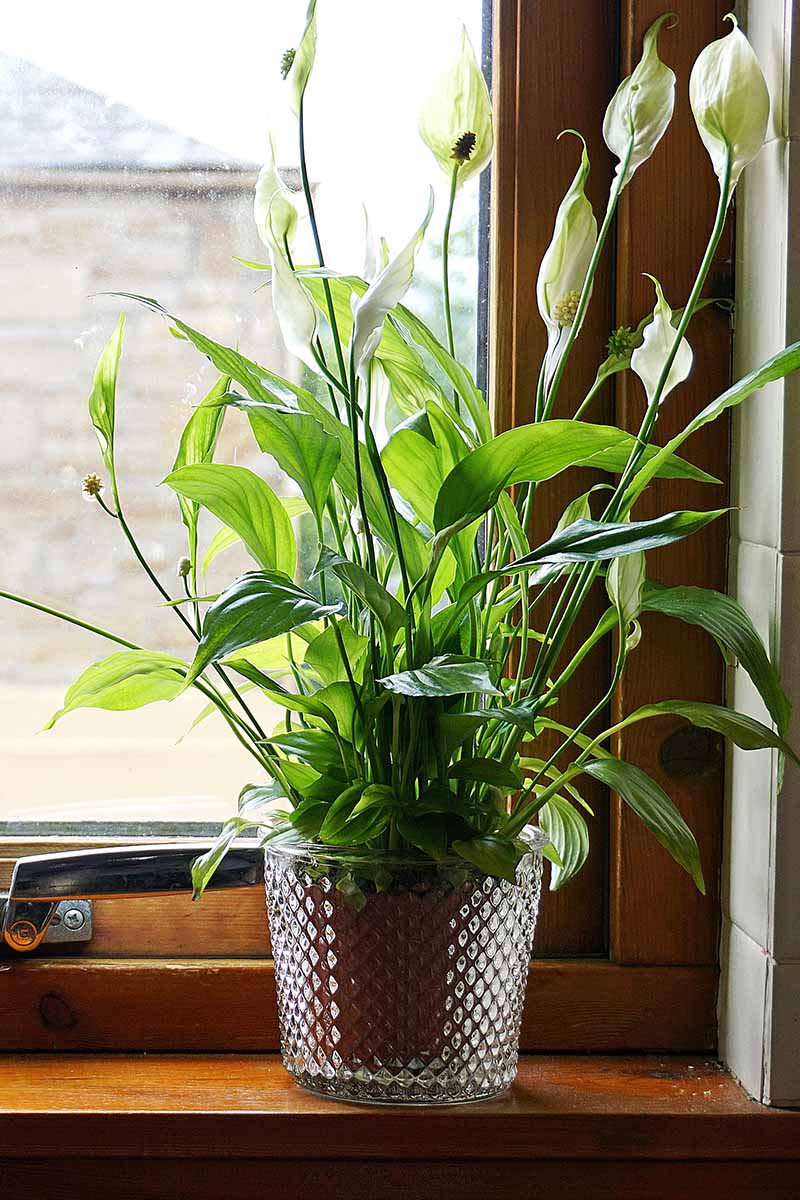Peace lilies have undeniably beautiful foliage, but the flowers are what make them stand out. There are so many houseplants out there that have interesting leaves, but there are precious few that blossom.
So it’s totally understandable that you want to make sure that your alluring houseplant flowers.
There are many reasons a peace lily will fail to bloom, which can make it a challenge to fix.

We link to vendors to help you find relevant products. If you buy from one of our links, we may earn a commission.
In this guide, we’ll explain what the causes are and how to identify which one is impacting your Spathiphyllum.
That way, you can resolve the situation, rather than make it worse with the wrong treatment.
Here’s what we’ll cover:
Peace lilies (Spathiphyllum spp.) aren’t actually lilies, even though their flowers somewhat resemble them. It’s just one of those fun naming quirks in the botanical world.
They’re actually more closely related to monsteras, philodendrons, and pothos. They grow in tropical areas of the world in the understory of rainforests.
Speaking of the flowers, those big white blossoms are actually modified leaves called spathes. The little spiky thing in the middle is called a spadix, and it holds the small, insignificant blossoms.

The modified flower acts as a flag, waving to pollinators to entice them to come and visit.
When you go to pick up your peace lily at the store, it’s often blooming, and you might assume that it will just keep doing so.
However, commercial growers often use a natural hormone called gibberellic acid to force the plants to bloom, rather than them doing so naturally.
If you need a refresher on how to grow and care for peace lilies, check out our guide.
There are five main reasons why your houseplant may not bloom so let’s dig in and bring those blooms back!
1. Age of the Plant
All life ages, and as it ages, it stops being able to reproduce. That’s true of humans and it’s true of plants as well.
The flower on your peace lily is its attempt at reproducing. While a peace lily will continue to send out new roots and leaves, eventually the plant will reach the end of its lifespan.

Peace lilies can live for years, but if you’ve had yours for nearly a decade, it’s entirely possible that your plant is just too old to send up flowers.
On the other end of the spectrum, young plants are also unable to reproduce. If your plant is young and less than two to three years old, it’s probably just too young to flower. It needs to be about two years old to flower reliably.
If your plant was flowering when you purchased it, despite being small and young, it was likely given gibberellic acid to force it to blossom.
You can be fairly certain this was the case if the plant is small and was blooming when you bought it, continued to bloom for a month or two, and then hasn’t bloomed again.
It’s safe to assume that any plant in a six-inch pot or smaller is too young. You’ll just need to give it a few years to mature. Until then, enjoy that gorgeous foliage.
2. Lack of Nutrients
While Spathiphyllum aren’t heavy feeders, like all plants, they need adequate nutrients. If you haven’t fed or repotted your peace lily in several years, it’s entirely possible that a lack of food is causing the lack of blossoms.
In the spring and summer, feed with a balanced houseplant fertilizer every three weeks.

AgroThrive General Purpose Fertilizer
Something like AgroThrive General Purpose Fertilizer, which you can pick up at Arbico Organics in 32 ounce or gallon containers is just right. Follow the manufacturer’s directions for either foliar or soil application.
If you use a slow-release fertilizer, only apply it once in the early spring and once again in the early summer.

If you haven’t repotted your plant in several years, it might be time for a soil refresh.
You don’t necessarily need to upgrade to a larger container, but you should remove the plant, brush away as much of the soil as you can, and repot it in fresh soil.
3. Low Light
A peace lily that isn’t receiving the light that it needs won’t flower. This is the most common cause of a lack of blossoms in a mature plant and also one of the easiest to fix.

The biggest challenge is determining if this is actually the cause. If your plant is the right age, and you’re providing the right amount of water and food, you can assume that a lack of light is the problem.
To be sure, use a light meter. I’m a big advocate of keeping a soil moisture meter that can also read light and pH in your gardening kit. They come in handy more often than you might expect.

Primen Moisture, pH, and Light Meter
I find that one with a flat face like Primen’s Soil Plant Moisture Meter, which is available at Amazon, is ideal. If you’d like to learn more about these handy tools and which are best suited to your needs, check out our guide.
Stick your moisture meter in the soil and give it a minute to read the light. You want to aim for at least 300 foot candles for a majority of the day, but preferably closer to 700.
It’s tempting to just assume that you can tell how much light is reaching a plant just by looking at the room, but the human eye is incredibly adaptable. After a short time, your eyes adjust to the light level, that’s why you can read a book in a dimly lit room as well as you can in a bright room.
While that’s great for our ability to see in a range of light, it makes it difficult for us to accurately determine the light level in a room. That’s why a tool that reads the light for you is so handy.
If you determine that lack of light is likely to be the problem, move the plant somewhere that it will receive more light. Remember, direct sunlight isn’t good, but bright, filtered, or indirect light is excellent.
These plants grow on forest floors. Picture the light that hits your face as you stroll in a tall forest – that’s what you’re aiming for. Try to give them this level of light for at least six hours a day.
If your plant has been growing in a very dimly-lit location, you should make this transition gradually over a week or so.
A quick note: don’t assume that just because you haven’t moved your plant recently that means the light hasn’t changed. A tree outside might have grown taller over the years, or a vine may have grown up your window, blocking some of the light without you even realizing it.
I’ve even run into problems when I forgot to clean my window screens one year and it changed the level of light entering my home.
Remember, your eyes are extremely adaptable and you might not have noticed a gradual change in light.
4. Temperature
If your peace lily is regularly exposed to temperatures under about 65°F, it likely won’t flower. In fact, unless the temperatures are closer to 85°F during the day, the chances of blossoms forming is further reduced.

If you have your plant in a spot that is a bit chilly – say, next to a window or an air conditioning vent – move it to a more suitable location.
You should avoid keeping your plant where air – either hot or cold – will blow directly on it, and place it somewhere it will be toasty a majority of the time. Either a bathroom or upper-floor room that faces west is usually one of the warmer places in a home.
Avoid spots near doorways or single-paned windows during the winter.
5. Time of Year
One of the things people love about peace lilies is that they can bloom any time of year. But they are technically seasonal bloomers, so while you might see blossoms year-round, you shouldn’t expect them.

Their natural flowering season is between February and September. If your plant isn’t blossoming between October and January, you may just need to wait until spring arrives.
Return to a State of Tranquility
While the above list includes the most common causes of a lack of flowers, keep in mind that any stress on the plant can result in a failure to bloom.
If your plant looks unwell, whether it is wilting or the foliage has turned brown or yellow, you’ll need to figure out the cause before you can expect those lily-like spathes to return.

Watch the temperature, light, and food, and you should be rewarded with a delightful display. Once those flowers return, come back and let us know in the comments section below what it took to fix things.
Can’t get enough Spathiphyllum goodness? We totally understand! You might be interested in some of our other peace lily articles including:
About Kristine Lofgren
Kristine Lofgren is a writer, photographer, reader, and gardening lover from outside Portland, Oregon. She was raised in the Utah desert, and made her way to the rainforests of the Pacific Northwest with her husband and two dogs in 2018. Her passion is focused these days on growing ornamental edibles, and foraging for food in the urban and suburban landscape.











